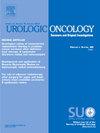评估bcg无反应和bcg暴露的非肌肉浸润性膀胱癌患者保膀胱治疗的肿瘤学结果。
IF 2.3
3区 医学
Q3 ONCOLOGY
Urologic Oncology-seminars and Original Investigations
Pub Date : 2025-07-31
DOI:10.1016/j.urolonc.2025.07.004
引用次数: 0
摘要
背景:一部分非肌性浸润性膀胱癌(NMIBC)患者介于BCG-naïve和bcg无反应之间,因此引入了“bcg暴露”类别。我们评估了接受保膀胱治疗(BST)的bcg无反应和bcg暴露患者的肿瘤预后。方法:本回顾性研究纳入了BCG无反应和BCG暴露的患者,这些患者接受了BCG联合BST或转向不同的膀胱内化疗。排除卡介苗失败后接受早期RC的患者(N = 14)。Kaplan-Meier (KM)曲线估计HG无复发生存期(HG- rfs)和无进展生存期(PFS)。结果:2005年1月至2022年9月接受BCG治疗的541例患者中,102例(19%)符合纳入标准,66例(65%)根据IBCG标准归类为BCG暴露,36例(35%)为BCG无应答。bcg衰竭的中位随访时间为43个月(四分位数范围:21-70)。49例患者在BST后出现第二次hg复发。其中8例进展。两组HG-RFS (P = 0.47)和PFS (P = 0.77) KM曲线差异无统计学意义。BCG暴露组治疗后3年HG-RFS为57% (95% CI: 43%-69%), BCG无应答组为39% (95% CI: 21%-57%) (HR: 1.24;95% ci: 0.69-2.21, p = 0.47)。结论:我们的分析显示,bcg暴露患者和bcg无反应患者的hg复发率或进展率无显著差异。在卡介苗失败复发时的分期,而不是自最后一次卡介苗治疗后的间隔时间,成为决定后续管理策略的主要因素。有必要通过更大规模的研究进行验证。本文章由计算机程序翻译,如有差异,请以英文原文为准。
Assessing oncological outcomes of bladder-sparing treatments in patients with BCG-unresponsive and BCG-exposed non-muscle-invasive bladder cancer
Background
A subset of non-muscle invasive bladder cancer (NMIBC) patients falls between BCG-naïve and BCG-unresponsive, leading to the introduction of the ‘BCG-exposed’ category. We assessed oncological outcomes in BCG-unresponsive and BCG-exposed patients undergoing bladder-sparing treatments (BST).
Methods
This retrospective study included BCG-unresponsive and BCG-exposed patients who underwent BST with BCG or a shift to different intravesical chemotherapy. Patients undergoing early RC after BCG failure (N = 14) were excluded. Kaplan-Meier (KM) curves estimated HG recurrence-free survival (HG-RFS) and progression-free survival (PFS).
Results
Among 541 patients treated with BCG from January 2005 to September 2022, 102 (19%) met inclusion criteria: 66 (65%) were classified as BCG-exposed according to IBCG criteria, 36 (35%) as BCG-unresponsive. Median follow-up from BCG-failure was 43 months (Interquartile range: 21–70). Forty-nine patients had a second HG-recurrence after BST. Of these, 8 patients progressed. No difference in KM curves was observed between the 2 groups for HG-RFS (P = 0.47) and PFS (P = 0.77). The 3-year HG-RFS after BCG treatment was 57% (95% CI: 43%–69%) for BCG-exposed and 39% (95% CI: 21%–57%) for BCG-unresponsive (HR: 1.24; 95% CI: 0.69–2.21, P = 0.47).
Conclusion
Our analysis revealed no significant differences in HG-recurrence or progression rates between BCG-exposed and BCG-unresponsive patients. Stage at the time of BCG failure recurrence, rather than the interval since the last BCG treatment, emerged as the primary factor in determining subsequent management strategies. Validation through larger-scale studies is warranted.
求助全文
通过发布文献求助,成功后即可免费获取论文全文。
去求助
来源期刊
CiteScore
4.80
自引率
3.70%
发文量
297
审稿时长
7.6 weeks
期刊介绍:
Urologic Oncology: Seminars and Original Investigations is the official journal of the Society of Urologic Oncology. The journal publishes practical, timely, and relevant clinical and basic science research articles which address any aspect of urologic oncology. Each issue comprises original research, news and topics, survey articles providing short commentaries on other important articles in the urologic oncology literature, and reviews including an in-depth Seminar examining a specific clinical dilemma. The journal periodically publishes supplement issues devoted to areas of current interest to the urologic oncology community. Articles published are of interest to researchers and the clinicians involved in the practice of urologic oncology including urologists, oncologists, and radiologists.

 求助内容:
求助内容: 应助结果提醒方式:
应助结果提醒方式:


